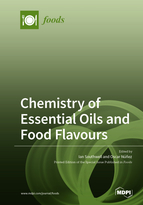Chemistry of Essential Oils and Food Flavours
A special issue of Foods (ISSN 2304-8158). This special issue belongs to the section "Food Physics and (Bio)Chemistry".
Deadline for manuscript submissions: closed (31 May 2021) | Viewed by 28909
Special Issue Editors
2. Editorial Board, Journal of Essential Oil Research
3. Chairman, Standards Australia, CH21 Essential Oil Committee
Interests: essential oils; plant chemistry; organic chemistry; structural elucidation; chemical ecology; bioactivity; essential oil authentication
2. Research Institute in Food Nutrition and Food Safety, Universitat de Barcelona, Av. Prat de la Riba 171, Edifici Recerca (Gaudí), E-08921 Santa Coloma de Gramenet, Spain
Interests: food authentication; food characterization; food classification; food fraud identification; secondary metabolites; polyphenols; foodomics; bioactive compounds; liquid chromatography; mass spectrometry; high resolution mass spectrometry; ambient mass spectrometry; capillary electrophoresis; chemometrics
Special Issues, Collections and Topics in MDPI journals
Special Issue Information
Dear Colleagues,
Essential oils have important functions in nature. In addition, they are used commercially as in such areas as flavours, fragrances and health-care products. Their properties present a challenge with respect to investigating their chemical structure, function, bioactivity, analysis and commercialization as value-added products. Analytical techniques for the investigation of essential oil chemistry are forever changing. The sophistication, adulteration or imitation of natural products is becoming difficult to detect as the perpetrators also use modern techniques. Consequently, an understanding of the chemistry of essential oils that keeps abreast with the latest in instrumental and computational developments is paramount.
Thus, the objective of this Special Issue is to broadcast the latest advances in essential oil discoveries with respect oil chemistry, methodology, instrumentation, bioactivity, chemical ecology, biosynthesis and authentication especially in relation to foods.
Dr. Ian Southwell
Prof. Dr. Oscar Núñez
Guest Editors
Manuscript Submission Information
Manuscripts should be submitted online at www.mdpi.com by registering and logging in to this website. Once you are registered, click here to go to the submission form. Manuscripts can be submitted until the deadline. All submissions that pass pre-check are peer-reviewed. Accepted papers will be published continuously in the journal (as soon as accepted) and will be listed together on the special issue website. Research articles, review articles as well as short communications are invited. For planned papers, a title and short abstract (about 100 words) can be sent to the Editorial Office for announcement on this website.
Submitted manuscripts should not have been published previously, nor be under consideration for publication elsewhere (except conference proceedings papers). All manuscripts are thoroughly refereed through a single-blind peer-review process. A guide for authors and other relevant information for submission of manuscripts is available on the Instructions for Authors page. Foods is an international peer-reviewed open access semimonthly journal published by MDPI.
Please visit the Instructions for Authors page before submitting a manuscript. The Article Processing Charge (APC) for publication in this open access journal is 2900 CHF (Swiss Francs). Submitted papers should be well formatted and use good English. Authors may use MDPI's English editing service prior to publication or during author revisions.
Keywords
- Essential oils
- Instrumentation
- Structure elucidation
- Bioactivity
- Flavour
- Authentication
- Biosynthesis
- Chemical Ecology








